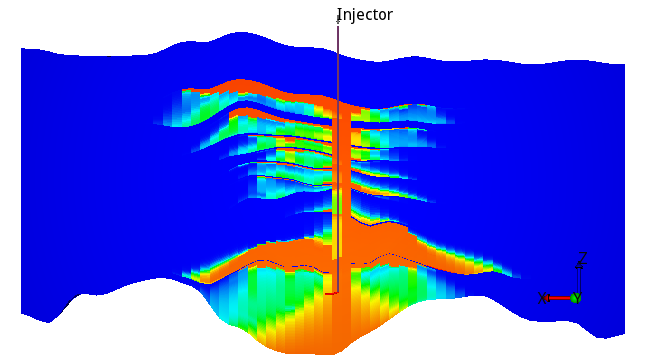HPCG2- Simulation tool for gigatonne carbon storage using high-performance computing (HPC) – phase 2.
Budget
15 MNOKCLIMIT Financing
65%Project number
622059Project partners
- • SINTEF Digital
- • TNO
- • Equinor
Project leader
NORCE Norwegian Research Center ASProject period
8/22-3/24Granted
21/06/2022Background
In the previous CLIMIT-DEMO project (620073), a crucial milestone was achieved with the release and demonstration of the CO2STORE module in the OPM Flow simulator (www.opm-project.org). This is a dedicated CO2 storage option that is easy to use, accurate, and efficient. The CO2STORE module was successfully applied to a regional multi-million cell model of Smeaheia. Further development is needed to (a) further improve computational speed and stability to allow efficient inclusion of dissolution processes and thermal effects in realistic field-scale simulations, (b) extend the use cases to new topics, e.g., storage in depleted hydrocarbon fields (c) collaborate with other storage simulation groups to develop an international benchmark for field-scale simulation of CO2 storage.
Goal
The overall goal of the project is to deliver an HPC-compatible CO2 storage simulator with advanced functionality to meet the challenge of Gigatonne storage. Our goal is to deliver a dedicated CO2 storage simulator that will be the preferred option for the CCS community.
Activities
The project will deliver an open-source simulator capable of simulating complex models with the necessary physics and resolution. The project has 4 work packages:
1. Improve HPC performance of the OPM Flow simulator with a goal of delivering a more scalable, robust, and efficient simulator.
2. Extend modelling capabilities in the simulator to efficiently simulate CO2 injection in depleted hydrocarbon fields.
3. Verify and demonstrate CO2 simulations that include dissolution processes and thermal effects in realistic field-scale settings.
4. Dissemination and preparation of an international CO2 storage benchmark for realistic simulations at the field scale.
Results
• The High Performance Computing (HPC) capabilities of the CO2 simulator have been significantly improved during the project. This is demonstrated by the successful simulation of a model with over 100 million cells running on an HPC cluster with 1,000 cores. This represents a significant improvement compared to the 10 million cell milestone achieved in an earlier project. To achieve this goal, the simulator has been improved in several aspects: (1) Better memory management, (2) general performance improvements, (3) improved tuning of linear and non-linear solvers for CO2 storage applications, and (4) improved algorithms for the partitioning of the domain for parallel simulations.
• A prototype compositional simulator has been developed. The compositional simulator can simulate simple compositional models relevant to CO2 injection in depleted fields. The results are benchmarked against research and commercial simulators.
• The simulator implements a novel upscaling approach for convective mixing. The upscaled model approximates the impact of convective mixing without resolving individual fingers, allowing for effective modeling of convective mixing on typical grids used for field-scale CO2 simulations.
• The simulator has been approved for usage in Equinor for the simulation of CO2 injection in saline aquifers. To obtain approval, the simulators have been rigorously tested and benchmarked against other simulators on an extensive range of test models with increasing complexity, including those with hysteresis and thermal effects.
• Results using OPM Flow were successfully submitted to the SPE11 CSP. No other participants submitted results with a higher grid resolution than OPM Flow.
• The number of users of the CO2 functionality has steadily increased during the project period.
Further Work
The project primarily focused on CO2 injection in saline aquifers and improvements aimed at enhancing HPC performance. This aligns with current priorities on the NCS. In the future, as more hydrocarbon fields approach the end of their production, the option of CO2 injection in depleted fields becomes an increasingly attractive alternative to CO2 injection in saline aquifers. This is already the case in the Netherlands, where CO2 injection in depleted gas fields is set to begin soon. Simulation of CO2 injection in depleted hydrocarbon fields offers distinctive and new challenges to the simulation tools.
For practical simulations, going beyond 100 million cells is often unfeasible due to high costs; however, there remains a need to enhance the HPC capabilities of the simulator beyond 100 million cells to run high-resolution simulations for benchmarking purposes. A high-resolution grid is necessary to accurately model the enhanced dissolution rate resulting from convective mixing.
Publications
Landa-Marbán, David, and Tor H. Sandve. “pyopmspe11: A Python framework using OPM Flow for the SPE11 benchmark project.” Journal of Open Source Software 10.105 (2025): 7357.
Nordbotten, Jan M., et al. “Benchmarking CO $ _2 $ Storage Simulations: Results from the 11th Society of Petroleum Engineers Comparative Solution Project.” arXiv preprint arXiv:2507.15861 (2025).
Mykkeltvedt, Trine S., Tor Harald Sandve, and Sarah E. Gasda. “New Sub-grid Model for Convective Mixing in Field-Scale CO 2 Storage Simulation.” Transport in Porous Media 152.1 (2025): 9.
Reiso, Edel, et al. “Lessons Learned in Using Open-Source Simulation Software on Real Asset Models.” SPE Reservoir Simulation Conference, SPE, 2025.

Cross section of simulated CO2 composition in 2050 based on the Sleipner field model accessible from co2datashare.org.

